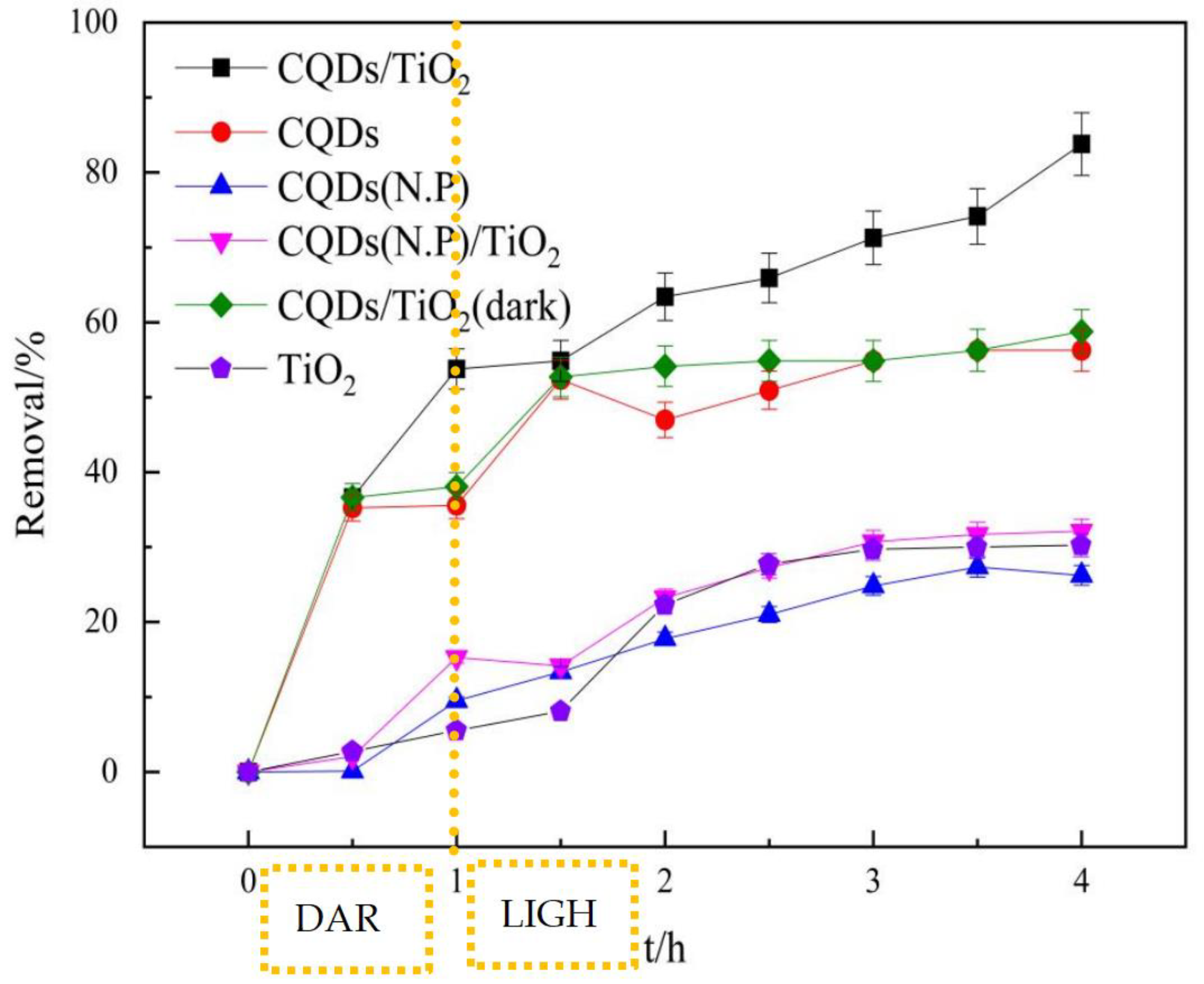A paper recently published in the journal Molecules investigated the feasibility of using a bio-carbon quantum dot (CQD)-decorated titanium dioxide (TiO2) (CQD/TiO2) for removal/photocatalytic degradation of naphthalene under sunlight irradiation/ visible light environment. Macroalgae served as the precursor for the CQDs in this research.
 Effect of different materials on the photocatalytic reaction of naphthalene. (N.P. means without pretreatment using dilute sulfuric acid). Image Credit: https://www.mdpi.com/1420-3049/29/11/2708
Effect of different materials on the photocatalytic reaction of naphthalene. (N.P. means without pretreatment using dilute sulfuric acid). Image Credit: https://www.mdpi.com/1420-3049/29/11/2708
Limitations of TiO2 Photocatalysis
Polycyclic aromatic hydrocarbons (PAHs) pose a significant risk to human health owing to their mutagenic, carcinogenic, and teratogenic effects. In recent years, TiO2 photocatalysis has gained significant attention as an aquatic PAH remediation technology owing to its robust capacity for oxidation, high catalytic efficiency, and good photochemical stability.
However, unmodified TiO2 displays low carrier utilization and is less active in the visible region due to its high rate of photo-generated electron-hole pair recombination and wide band gap, which significantly hinder its extensive adoption. Several studies have been performed to develop modified TiO2 photocatalyst systems to maximize visible light utilization.
The Potential of CQDs
Carbon doping technologies can overcome several limitations of TiO2, such as its poor light absorption and utilization. Among these technologies, carbon quantum dots (CQDs) stand out due to their efficient electron transfer, easy tunability, up-conversion fluorescence, and strong photoluminescence.
However, the top-down method traditionally used for preparing CQDs faces limitations, including the requirement for carbon precursors with a large sp2 hybridization area. Conversely, the bottom-up synthesis method is widely favored for its practicality and simplicity.
Recently, the use of eco-friendly, affordable, and readily accessible natural resources as carbon precursors has gained traction in research. Particularly, the production of CQDs from biomass—especially waste biomass—has become a focus of study. For example, a recent study utilized the fast-growing macroalgae Sargassum horneri (S.H.) as a precursor for CQDs.
The Proposed Approach
In this study, CQD/TiO2 was synthesized using an ultrasonic doping method and applied in naphthalene's photocatalytic degradation under sunlight irradiation. The CQDs were prepared from a typical macroalgae, S.H., through hydrothermal synthesis and diluted sulfuric acid pretreatment using an optimal design with 3.0 % sulfuric acid and a hydrothermal condition of 200 °C.
Biomass CQDs can combine with semiconductors like TiO2 to form potential photocatalysts, as their surface is rich in oxygen-containing functional groups. Recent studies have shown that algae and their derived carbon materials act as co-catalysts when combined with TiO2.
However, CQD/TiO2 photocatalysts synthesized using biomass are also impacted by their complex biological compositions, which necessitates the development of a suitable pretreatment method to destroy the natural plant structure's cellulose and increase the porosity and specific surface area of raw materials.
In this work, pretreatment using dilute sulfuric acid was performed to realize both objectives. Specifically, the porosity and specific surface area of the S.H. were increased, and a 10-fold rise in CQD yield, from 2.3 % to 18.9 %, was achieved using the pretreatment method.
The diluted acid pretreatment successfully broke down lignin and hemicellulose in the biomass, aiding in the synthesis of carbonaceous materials. Subsequently, the mixture was centrifuged at 10,000 rpm for one minute, repeated three times, to remove large particles from the resulting CQDs
Following this, a 0.22 μm polyethersulfone membrane was utilized to neutralize and separate the components, yielding a liquid CQD solution. This liquid was then freeze-dried to produce a solid CQD powder. The photocatalytic activity of the CQD/TiO2 composites was tested using naphthalene as the target pollutant. For the photodegradation experiments, a photochemical reactor equipped with a xenon arc lamp simulated sunlight irradiation
Importance of this Work
CQDs were successfully synthesized using marine biomass, specifically S.H., through a straightforward hydrothermal method. The CQD/TiO2 composites were then expertly crafted using an ultrasonic technique. This study confirmed that macroalgae serve as an effective precursor for CQDs.
The dilute sulfuric acid pretreatment not only enhanced the combination and adsorption performance of the CQDs but also improved the synthesis of the CQD/TiO2 composites, significantly boosting their photocatalytic activity. As the concentration of CQDs in the CQD/TiO2 composites increased, the photocatalytic efficiency for degrading naphthalene initially rose, peaking at 86.63 % efficiency with a 10 mL CQD loading before slightly diminishing with further additions.
Furthermore, the degradation of naphthalene under visible light conditions revealed a synergistic interaction between the TiO2 and CQDs, markedly enhancing the generation of reactive oxygen species. Additionally, the nitrogen derived from the S.H. macroalgae was found to accelerate the photocatalytic process. Kinetic analysis indicated that the photocatalytic activity of the CQD/TiO2 composites adhered to a pseudo-first-order reaction.
In summary, this study illustrated the practicality of using bio-CQD/TiO2 composites for effective naphthalene removal under sunlight irradiation and provided valuable insights into leveraging macroalgae as a resource in environmental remediation.
Journal Reference
Chen, Y., Hong, C., Xu, Q., Zheng, H., Wang, C., Lu, H., Zhang, S., Du, M., Zeng, G. (2024). Visible Light Enhancement of Biocarbon Quantum-Dot-Decorated TiO2 for Naphthalene Removal. Molecules, 29(11), 2708. https://doi.org/10.3390/molecules29112708, https://www.mdpi.com/1420-3049/29/11/2708
Disclaimer: The views expressed here are those of the author expressed in their private capacity and do not necessarily represent the views of AZoM.com Limited T/A AZoNetwork the owner and operator of this website. This disclaimer forms part of the Terms and conditions of use of this website.
Article Revisions
- Jun 14 2024 - Title changed from "CQD-Titanium Dioxide Composite Boosts Sunlight Photocatalysis" to "Bio-Carbon Quantum Dots Boost TiO2 Photocatalytic Performance"